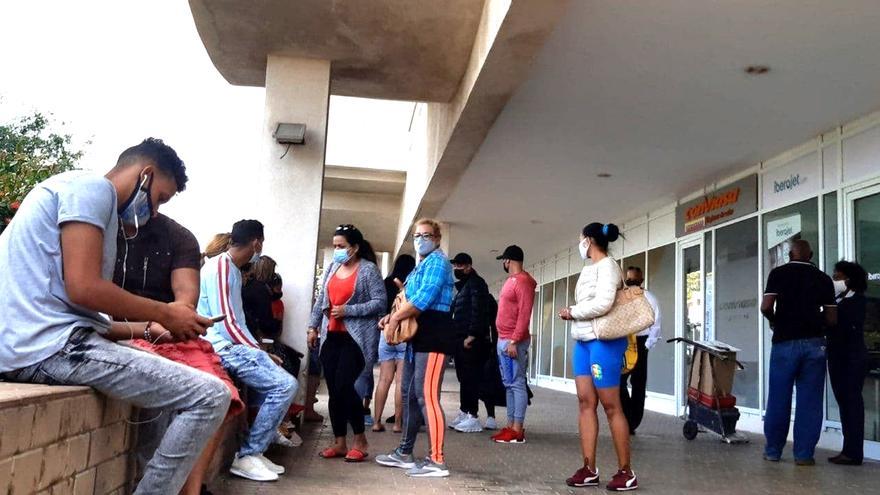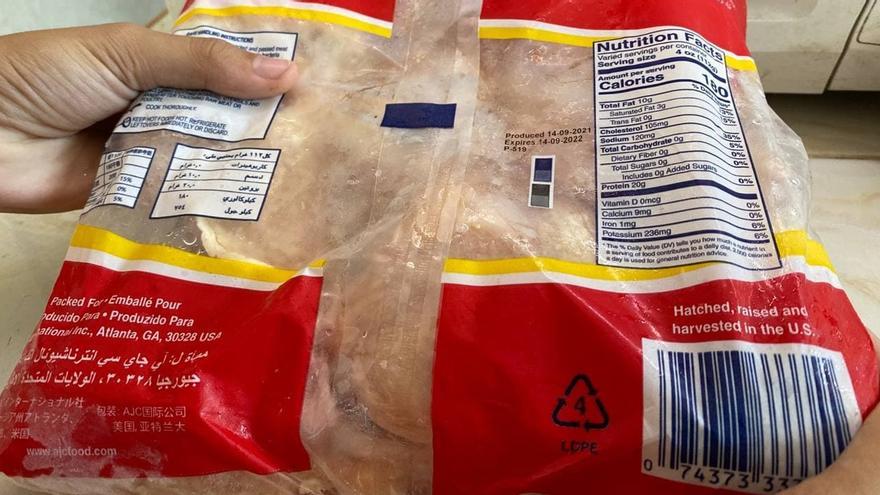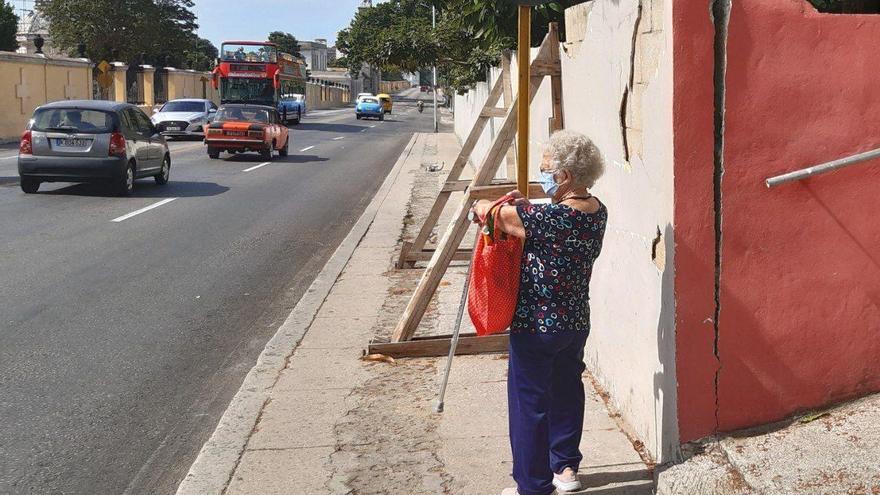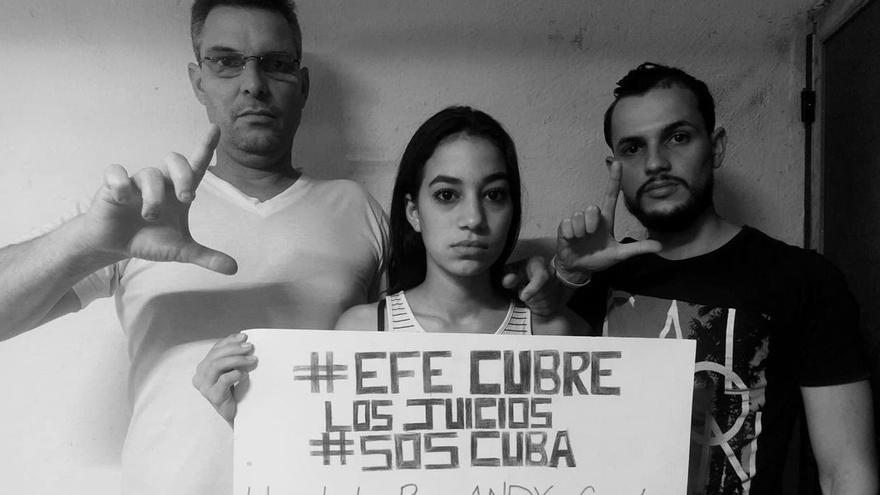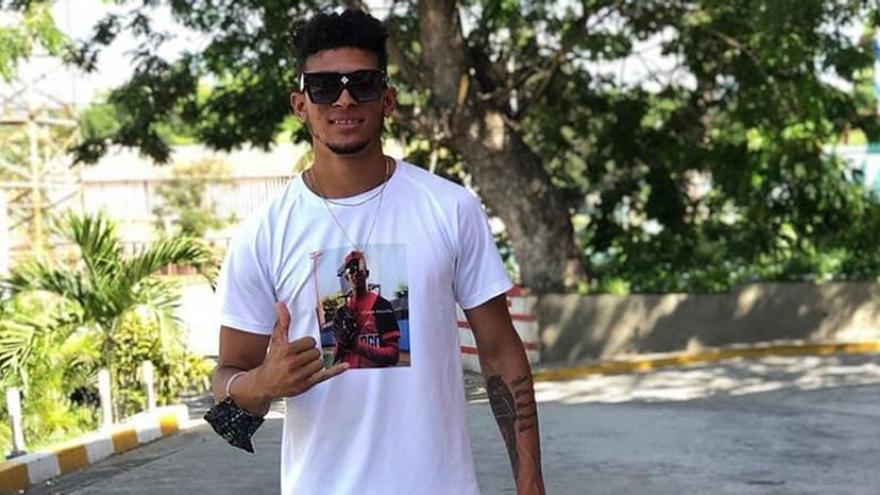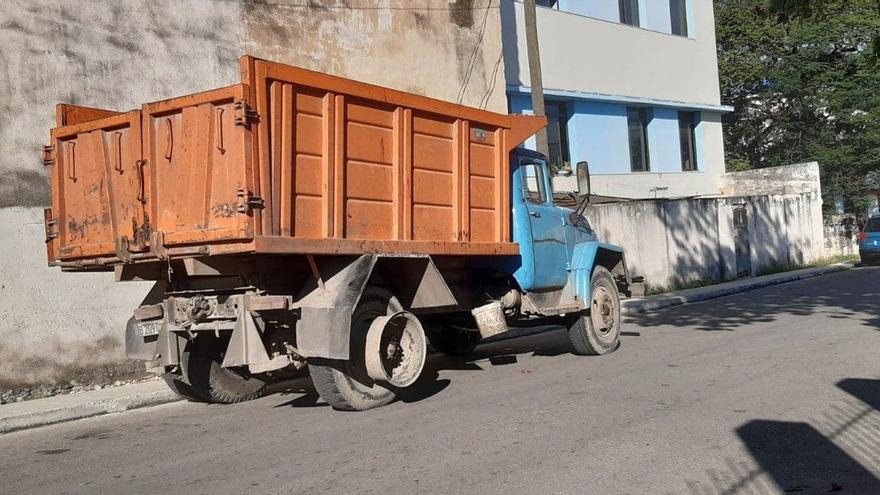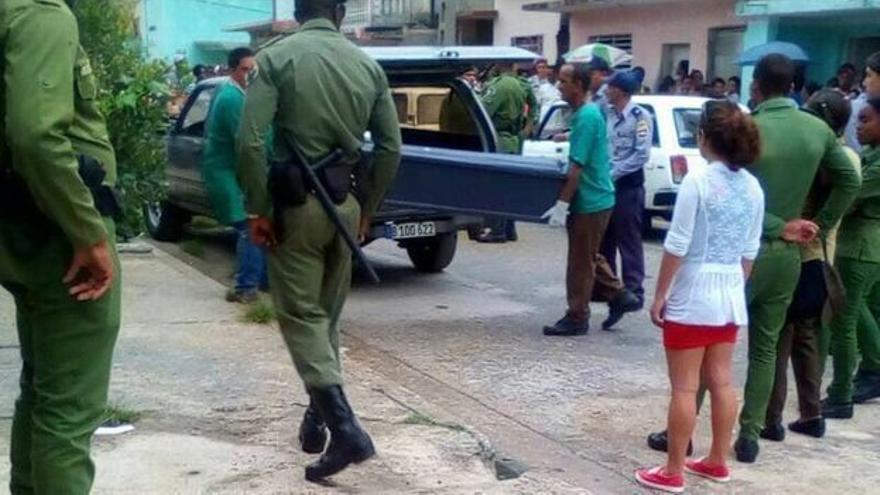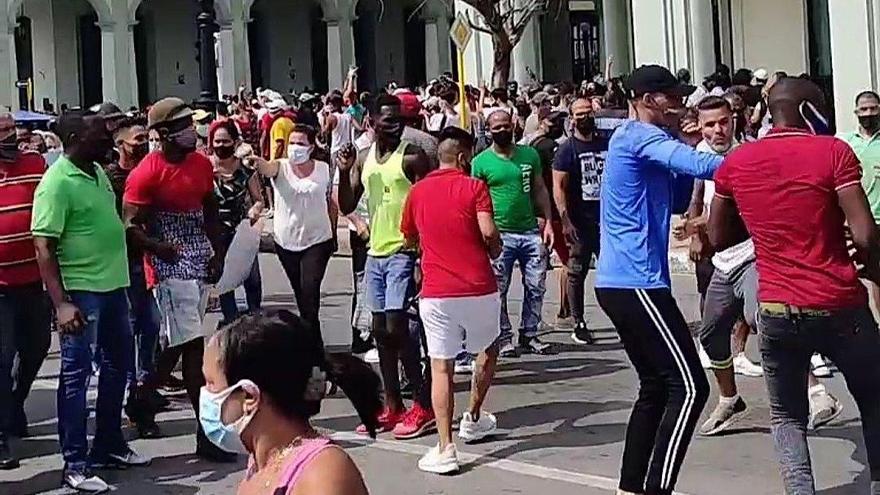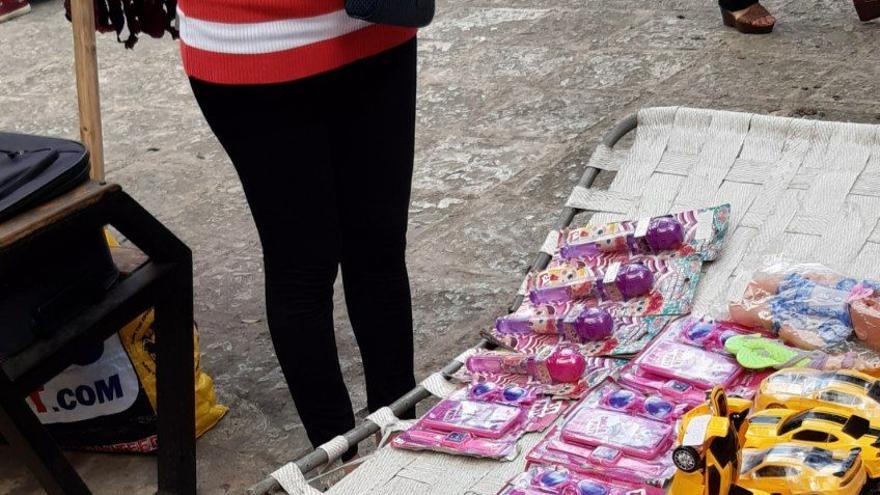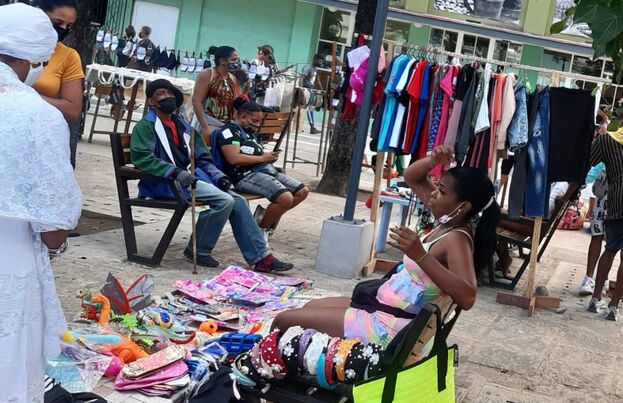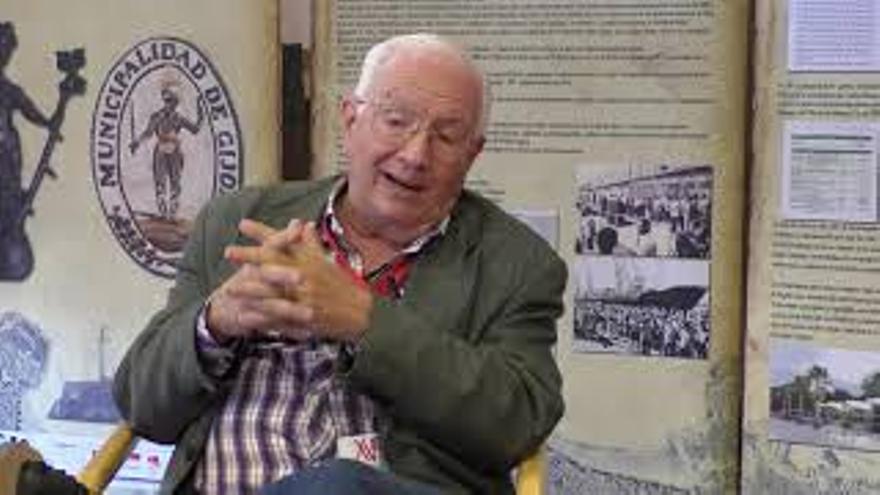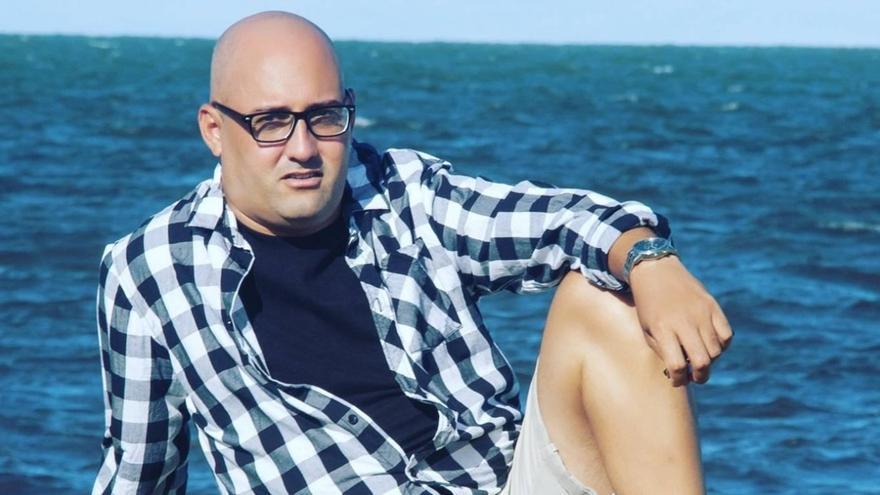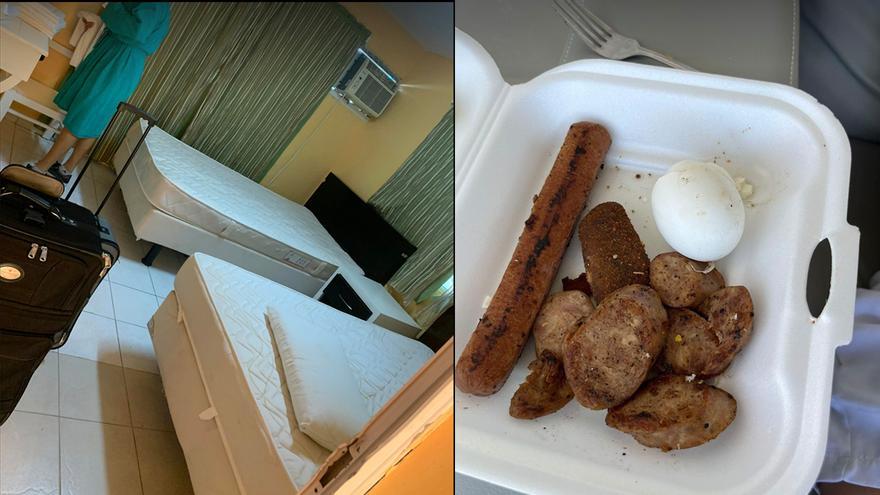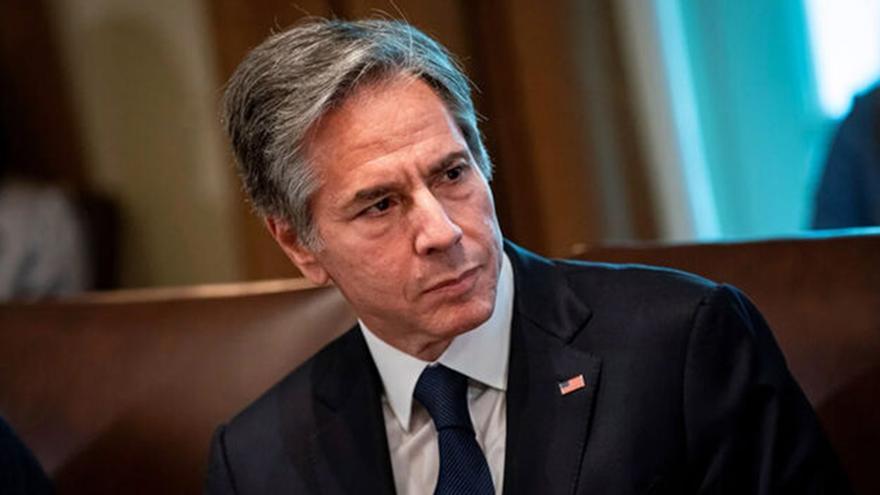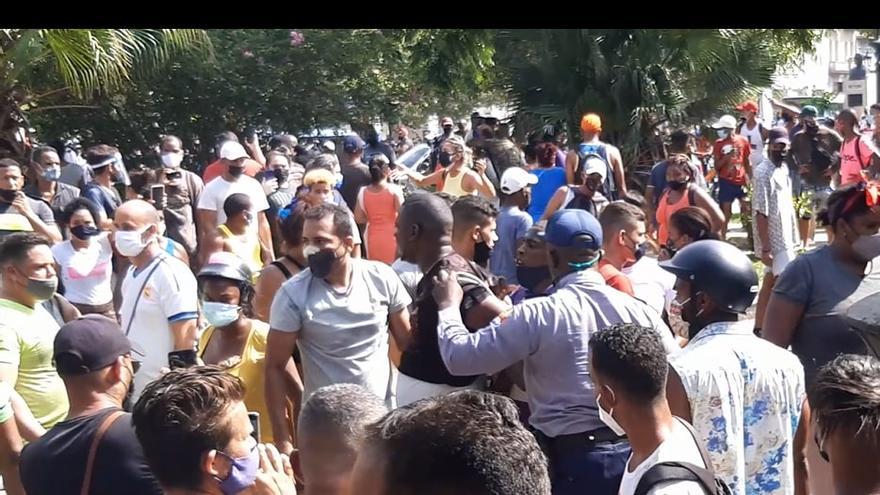Even so, in the capital those situations were more difficult. We still had fresh in our minds the defeats of November 27, 2020 and January 27, 2021 in front of the Ministry of Culture. Both could have been opportunities to have put the system in check, but they only led to more than beatings, triumphant speeches, justifications for cutting off the internet and destroyed phones.
I think about that when I get to 23rd and M, right in front of the entrance of the ICRT [Cuban Institute of Radio and Television]. A group of young people is protesting and asking for a time in front of the microphones or the cameras of the national television. In front of them, a small representation of workers carry pro-government slogans.
As the minutes go by, this group increases with individuals arriving on various buses with Cuban flags, until they become a mob that, fired up and already confident of being the majority, draws close to the young protestors and does not allow them to leave until, in a ghostly way, a truck appears and, with unwarranted violence, they begin to push the young people towards it.
It was the first scene of riots that I saw on the afternoon of July 11 in Havana. The young people shouted “Cuba belongs to everyone” from the top of the truck and they were accompanied by a curious demonstration of people all continue reading
over Avenida 23, from M to I. In a state of shock, I planned to go to the Malecón, where they told me the largest number of people was concentrated.
On the way there, I ran into a friend who tells me that at 4:00 pm the President will speak on National Television. It is the sadly famous speech where he calls on the revolutionaries to take to the streets and not to surrender the Revolution. In that intervention, Díaz-Canel gave, with his final words, ’the combat order’, which raised fear of a possible civil war.
The bus that takes us to Old Havana is loaded with an aura of excitement never seen before. In this environment, suddenly a girl stands up and begins to shout anti-government slogans, to applaud, to demand freedom and to recite the verses of Bonifacio Byrne in Mi Bandera. The bus becomes, by the second, the freest place in Cuba, where each and every one smiles happily at being able to say what they had choked on for so many years.
We got off very close to the Deauville hotel, the epicenter of the 1994 protests [The Maleconazo], we walked shouting slogans and telling the neighbors to get out of their houses, until we reached La Fraternidad Park, next to the Capitol.
In this section many people are joining us, young people, old people and children. In flip-flops, no shirts, just woken up or off work that afternoon. All eager for freedom. In front of the América theater, a demonstration organized by the Government, well escorted by police cars, military jeeps and agents stationed on the corners of Neptuno and Galiano, strolls without generating anything other than curiosity and laughter. It was one more sign that we have a pitifully ridiculous and pantomimic system.
The view offered by the esplanade in front of the Capitol was indescribable: around 1,500 people, maybe 2,000, chanted the word freedom. The title of the song Patria y Vida [Homeland and Life], turned into a motto, was an overwhelming roar. “Diáz-Canel Out,” “resign” and “Díaz-Canel, singao [motherfucker]” were heard all over the place.
I had already heard that Camagüey, Ciego de Ávila, Palma Soriano, Santiago de Cuba, Matanzas and other municipalities in Cuba were on their feet, facing the Police and demonstrating that freedom, no matter how much a system ignores it, is the greatest thing that exists. He was facing an unspeakable, incredible scenario: thousands of people in Cuba had taken to the streets to demand from the Government what had long been dissatisfactions.
Not for pleasure, for two days the #SOSCuba campaign had managed to be a trend on Twitter, and not only because of the call of the influential Mia Khalifa.
I am running towards a police truck when, suddenly, I feel squeezed as if by a thousand hands that paralyze me. They yell at me, throw me to the ground and hit me on the knee. The people around me try to separate them from me, but it is impossible for them and they only film, document such atrocity and disown them.
From what is stopping me, a hand squeezes my throat and says “You black shit, you scream again and I’ll crush your throat.” The hand is that of a boy no more than 20 years old, maybe less, who exudes an indescribable hatred from his eyes. It is not a legitimate or personal hatred against me: it is hatred inoculated by a system towards everyone who thinks differently. Thus, in semi-consciousness, I wish him peace and resign myself to arrest.
The patrol in which they put me goes at about 120 kilometers per hour and leaves me at the door of the Zanja station, where I enter through the entrance on Escobar street. Outside the building there is a group of people giving moral support to all of us who are entering little by little without knowing when we will leave.
I ask the officer to tell me under what crime he is detaining me, if I can file the writ of habeas corpus or call a lawyer. All this is part of the detention protocol explained in the Constitution and by the announcer and member of the Central Committee of the PCC (Communist Party of Cuba) Humberto López in the program Hacemos Cuba. Knowing in advance that it is impossible to access all this, I do so in order to be able in the future to affirm with all conviction that my detention is arbitrary and violates the provisions of current laws.
I am stripped of my belongings and thrown into a cell measuring about 20 by 25 feet where there are about 150 people. It is 5:35 pm.
What I have experienced in that place up to the moment of my release is an unequivocal sign that we live in a State that not only violates some universal human rights principles, but also violates its own legal system, and that intolerance towards those who disagree it is greater than any other crime.
In that cell it is infectious, the air is unbreathable and the heat suffocating. In an attempt to survive, I approach the bars and stand there, imploring all the officers who pass by for some water. I receive the first glass three hours later.
It is curious how the epidemiological situation in the country was never taken into account in that cell. On the contrary, it seemed that we were being urged to contract COVID-19 and die. While each morning Dr. Francisco Durán recommended a series of measures, among which were avoiding overcrowding and maintaining social distancing, the Government locked hundreds of people in cells without conditions with the simple objective of demonstrating power.
We were all there for the same reason. There was not a single person who had entered for another reason. Some for being directly at the protest, others for supporting it with applause from outside and the least for showing curiosity. There was even a man held for giving a group of protesters a bottle of water.
Perhaps ignoring that, the station Police crashed before the integrity and brotherhood that was formed in seconds in that space full of men eager for freedom. The entry of a new detainee (which happened all the time) was a moment where freedom was applauded and shouted, perhaps with more meaning than outside, in the street.
There were people of all ages, including three minors, and also an Italian couple and a Belgian. Everyone told how they got there, and in all the stories there was one word in common: violence.
I remember the entry of several detainees held by the neck by officers, crashed to the ground, kicked, slapped and humiliated. Two cases particularly struck me. The first, a thin, bearded boy, who arrived dragged by a lieutenant twice his width who, just before putting him in the cell, slapped him until blood was drawn from his nose. That boy was in such a state of alienation that he just looked sideways and laughed. I wonder what happened to him.
The other was a black boy, thrown to the floor and dragged towards the cell, who, on the way, shouted that he was from the UJC [Union of Young Communists] and that they please call the unit politician. They shut him up with a fist.
Around 6:40 am they take me out of the cell and take me to an office labeled “Carpeta 2″. There they take my data, they confiscate my identity card and they ask me the reasons for my arrest, reasons that I myself did not know. The interview is conducted by an official from the Department of State Security. Who is, likewise, a young boy, no more than 25 years old, with penetrating green eyes that, above the mask, do not stop judging me.
After about 15 minutes he tells me that they are going to check all the data and if I have no previous problems, that is, a criminal record, I will be released in a few hours. It is the first time I have heard that word from one of them.
They take me to another cell, five by 12 feet. That’s where I think of my family for the first time. I know they will be worried because, knowing me, they must have inferred that I was going to join the protests. I hope to leave before 9:00 pm, the time of the curfew imposed due to covid-19 by the provincial government. It’s where I smoke for the first time since I’ve been detained.
Silently, a newcomer passes me a cigarette that I inhale anxiously, wondering how intolerant and proud a government would haveto be to be unable to understand a peaceful protest and instead fill the police stations with people (there were already about 250 between the two cells, and about 60 in the corridor, heavily guarded by armed officers). Many newcomers commented that they had heard that the Zapata and C and Cuba and Chacón stations were also overflowing. Cubans continued to protest in the streets.
The hours that remained I used to memorize each moment, each action and each person that could appear in this text. The leading role was undoubtedly taken by the officer who led the cell guard that day. He was what in Cuba we call a jabao, short, burned by the sun and strengthened by constant training sessions. A brutalized, semi-primitive man, blinded by the momentary power that gives him the blue uniform and the pistol that hangs in his zambrán (holster).
With a crooked laugh, he would come over and tell us that we weren’t going to get out of there to tell about it. He was the one who, when in the neighboring cell they began to sing the national anthem and demand the resignation of the president, he withdrew the water and took out a few, beat them in front of all of them and sent them to the jail.
The dungeon, a place that I did not have the pleasure of knowing, by chance, was the women’s cell. These, although in much smaller numbers than the men, perhaps fifteen, were detained by both female and male officers. With the advantages that their sex offered at that time, they directly offended those who took them the same way towards the end of a side corridor, the end of which I could never decipher, or who left them, separated from their companions. The outer space of the cells, at the end of my stay, was occupied by almost 70 people.
After hours listening to shouts, complaints, applause, offenses, slogans (especially “Patria y Vida”) and the lyrics of the national anthem (which will have been sung about 11 times), they open my cell and say my name. It is 11:20 pm.
The officer, this man with wild movements and a cyclopean attitude, hands me my identity card and my belongings and utters the only words that sounded strangely kind in his mouth: “Get up, kid.” They did not make me sign any paper, nor levy the famous fines for the spread of epidemic and public disorder that we deduced in the cells that they were going to put on us. I suppose that the fewer records of detainees, the easier it is to show that the protests were carried out by just “four cats.”
On the street I noticed that my belt was broken, just like my shirt. That my mask had disappeared (I used the one that a cellmate gave me) and that sweat and a bad smell flooded me. I noticed the dirt on my shoes and bag, the pain in my knee (which turned out to be a sprain caused by the beating at my arrest), and the almost four miles I had to walk home.
The last memory I took with me was the sound of telephones ringing in the holding room for belongings, opposite the cell. They never stopped ringing the whole time I was there and I think it will be a memory that I will have in my brain for a lifetime. They sounded desperate. Despair from friends and family.
I made the journey in about an hour and fifteen minutes. Along the way I saw only police patrols. However, the scenario along the 10 de Octubre Avenue, from Cristina to Jesús del Monte, had prepared for me was something incredible. Stones, glass and broken bottles, shops smashed and looted. The corner of Toyo was, evidently, the center of the fight that Sunday of San Abundio.
When I arrived at my house, my parents waited for me with the expression of those families who, in the times of Batista, were looking for their children among the dead in a police fight. There were no words, no tears, no hugs. I went, limping and practically unable to speak, straight to the bathroom, processing everything that had happened in the last hours.
This was the beginning of the end. They all knew it. Whatever the president said on television, the people had already spoken. The thousands of people I had seen shouting “we are not afraid,” “freedom” and “the people united will never be defeated” confirmed it to me.
The crude and deceitful government strategies of plainclothes policemen, buses loaded with workers sent to the insurgent hotspots to be presented as the spontaneous people, and the absurd blame placed on the United States Government demonstrated such a great disconnect between the State and the people that sooner or later it will cost them, the Revolution or a civil war.
____________
COLLABORATE WITH OUR WORK: The 14ymedio team is committed to practicing serious journalism that reflects Cuba’s reality in all its depth. Thank you for joining us on this long journey. We invite you to continue supporting us by becoming a member of 14ymedio now. Together we can continue transforming journalism in Cuba.

![]() 14ymedio, Havana, 7 January 2021 — “We are going to support them to do whatever they want to do,” says the Foreign Minister of El Salvador Alexandra Hill in relation to independent journalists Esteban Rodríguez and Héctor Luis Valdés Cocho, who were admitted to the Central American country last Wednesday after being forced to leave Cuba.
14ymedio, Havana, 7 January 2021 — “We are going to support them to do whatever they want to do,” says the Foreign Minister of El Salvador Alexandra Hill in relation to independent journalists Esteban Rodríguez and Héctor Luis Valdés Cocho, who were admitted to the Central American country last Wednesday after being forced to leave Cuba.
